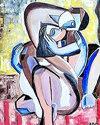“索引注释”
IF 0.3
4区 社会学
0 HUMANITIES, MULTIDISCIPLINARY
ANGELAKI-JOURNAL OF THE THEORETICAL HUMANITIES
Pub Date : 2023-07-04
DOI:10.1080/0969725X.2023.2233809
引用次数: 0
摘要
摘要当代艺术越来越多地回归指数的概念,以描绘气候崩溃造成的缓慢变化和灾难性破坏。通过吉迪恩·孟德尔的系列摄影作品《水印》(自2011年起)、西川智奈里的短片《百万虫之声》、《千星之光》(2014年)和圣地亚哥·塞拉的装置作品《暴露在墨西哥城空气中的52个画布》(2019年),本文分析了采用直接暴露于元素和毒性的模拟技术的三个位置。他们使用该索引来创作艺术品,作为人类和非人类见证工作的合作见证,促使人们暂时重读罗莎琳德·克劳斯的两部分文章《索引笔记》(1977)。这种重读的核心是证词的形式。我将其描述为指数抽象,在其中看到与世界有物质联系的图像,但却以非模仿的方式表达了这种参与。这些作品引用了抽象艺术的习语,不仅表明现代主义让地球陷入了困境,而且还发现了一种超越线性视角的绘画密码。通过这样做,他们表达了蒂莫西·莫顿所说的气候变化的超对象,创造了将图像和想象力结合在一起的画面,从而要求观众小心地接近他们——以及他们所指的世界。本文章由计算机程序翻译,如有差异,请以英文原文为准。
“Notes on the Index”
Abstract Contemporary art is increasingly reverting to notions of the index to image the slow changes and catastrophic destructions caused by climate breakdown. Looking at Gideon Mendel’s photo series Watermarks (since 2011), Tomonari Nishikawa’s short film sound of a million insects, light of a thousand stars (2014), and Santiago Sierra’s installation 52 Canvases Exposed to Mexico City’s Air (2019), the essay analyzes three positions that employ analog techniques of direct exposure to the elements and to toxicity. They use the index to create artworks that function as collaborative testimonies of human and non-human witnessing work, prompting a re-reading of Rosalind Krauss’ two-part essay “Notes on the Index” (1977) for the present. Central to such a re-reading is the form the testimonies take on. I describe them as indexical abstractions, seeing in them images that are materially connected to the world yet expressing that involvement in non-mimetic ways. The works cite the idiom of abstract art not only to show that modernism has put the planet into distress but to also find a pictorial code operating beyond the confines of linear perspective. By doing so, they give expression to what Timothy Morton has called the hyperobject of climate change, creating pictures that combine image and imagination, thereby asking viewers to approach them – and the world they index – with care.
求助全文
通过发布文献求助,成功后即可免费获取论文全文。
去求助
来源期刊

ANGELAKI-JOURNAL OF THE THEORETICAL HUMANITIES
HUMANITIES, MULTIDISCIPLINARY-
CiteScore
0.60
自引率
33.30%
发文量
57
期刊介绍:
Angelaki: journal of the theoretical humanities was established in September 1993 to provide an international forum for vanguard work in the theoretical humanities. In itself a contentious category, "theoretical humanities" represents the productive nexus of work in the disciplinary fields of literary criticism and theory, philosophy, and cultural studies. The journal is dedicated to the refreshing of intellectual coordinates, and to the challenging and vivifying process of re-thinking. Angelaki: journal of the theoretical humanities encourages a critical engagement with theory in terms of disciplinary development and intellectual and political usefulness, the inquiry into and articulation of culture.
 求助内容:
求助内容: 应助结果提醒方式:
应助结果提醒方式:


